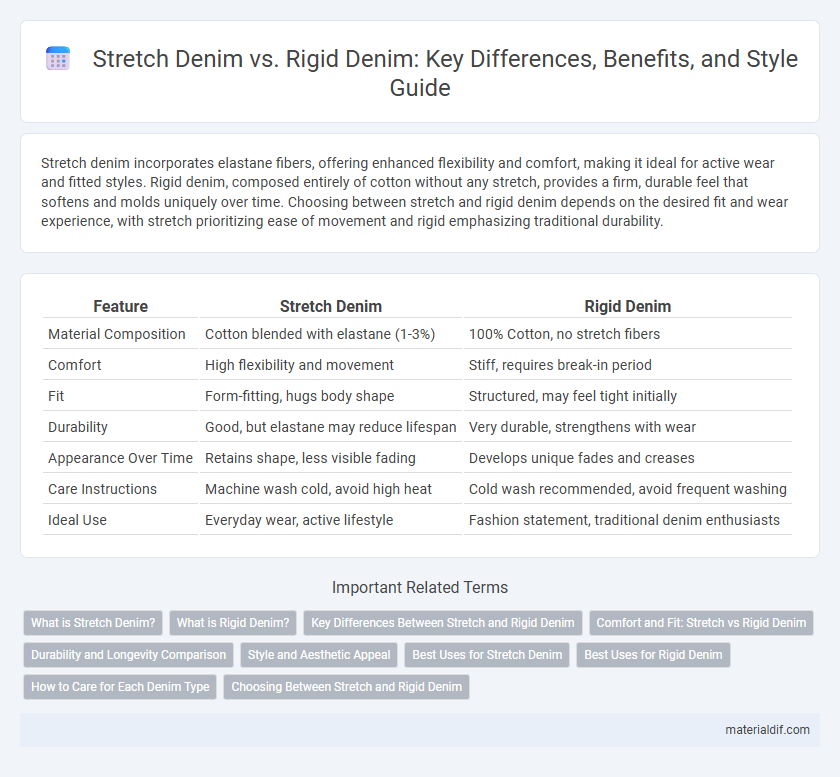Stretch denim incorporates elastane fibers, offering enhanced flexibility and comfort, making it ideal for active wear and fitted styles. Rigid denim, composed entirely of cotton without any stretch, provides a firm, durable feel that softens and molds uniquely over time. Choosing between stretch and rigid denim depends on the desired fit and wear experience, with stretch prioritizing ease of movement and rigid emphasizing traditional durability.
Table of Comparison
| Feature | Stretch Denim | Rigid Denim |
|---|---|---|
| Material Composition | Cotton blended with elastane (1-3%) | 100% Cotton, no stretch fibers |
| Comfort | High flexibility and movement | Stiff, requires break-in period |
| Fit | Form-fitting, hugs body shape | Structured, may feel tight initially |
| Durability | Good, but elastane may reduce lifespan | Very durable, strengthens with wear |
| Appearance Over Time | Retains shape, less visible fading | Develops unique fades and creases |
| Care Instructions | Machine wash cold, avoid high heat | Cold wash recommended, avoid frequent washing |
| Ideal Use | Everyday wear, active lifestyle | Fashion statement, traditional denim enthusiasts |
What is Stretch Denim?
Stretch denim is a type of fabric that incorporates elastane fibers, typically around 1-3%, blended with cotton to provide flexibility and comfort. Unlike rigid denim, stretch denim offers enhanced mobility, making it ideal for form-fitting jeans and active wear while maintaining the classic denim look. This fabric adapts to body movements, reducing stiffness and increasing wearability for everyday use.
What is Rigid Denim?
Rigid denim is a type of denim fabric that is untreated and unwashed after the dyeing process, preserving its original dark indigo color and stiff texture. Known for its durability and ability to develop unique fades and creases over time, rigid denim molds to the wearer's body, providing a personalized fit. This type of denim is favored by enthusiasts who appreciate raw, authentic fabric that evolves with wear and time.
Key Differences Between Stretch and Rigid Denim
Stretch denim incorporates elastane fibers, offering enhanced flexibility and comfort, making it ideal for form-fitting garments and active wear. Rigid denim consists solely of 100% cotton without stretch, providing a stiffer texture and durability preferred for traditional raw denim jeans with pronounced fading over time. The key differences lie in their composition, fit, and wear characteristics, with stretch denim allowing greater mobility and rigid denim delivering structure and long-term aging appeal.
Comfort and Fit: Stretch vs Rigid Denim
Stretch denim incorporates elastane fibers, providing enhanced flexibility and a close, adaptive fit that moves with the body, making it ideal for comfort and active wear. Rigid denim, made from 100% cotton without stretch, offers a structured fit that molds to the wearer's shape over time but initially feels stiffer and less forgiving. The choice between stretch and rigid denim impacts comfort levels and fit preferences, with stretch denim favoring immediate comfort and mobility, while rigid denim appeals to those seeking a classic, durable silhouette.
Durability and Longevity Comparison
Stretch denim incorporates elastane fibers, providing enhanced flexibility but slightly compromising durability compared to rigid denim, which consists of 100% cotton with a tighter weave that withstands wear and tear more effectively. Rigid denim maintains its shape and structure longer, making it ideal for heavy-duty use and extended longevity, while stretch denim may show signs of fabric fatigue and sagging sooner. For durability-focused consumers, rigid denim is preferable, whereas stretch denim offers comfort with a trade-off in lifespan.
Style and Aesthetic Appeal
Stretch denim offers a sleek, body-hugging silhouette that enhances comfort and allows for versatile styling, making it ideal for contemporary fashion trends. Rigid denim, known for its structured and authentic look, develops unique fades and creases over time, appealing to enthusiasts seeking a classic, vintage aesthetic. Both fabrics cater to different style preferences, with stretch denim providing modern flexibility and rigid denim delivering timeless character.
Best Uses for Stretch Denim
Stretch denim, infused with elastane or spandex fibers, offers enhanced flexibility and comfort ideal for active wear and form-fitting styles. Best suited for skinny jeans, jeggings, and athleisure, stretch denim adapts well to body movements without losing shape. Its elasticity also benefits apparel requiring durability with a snug fit, such as leggings, casual tops, and stretchable denim skirts.
Best Uses for Rigid Denim
Rigid denim, characterized by its 100% cotton, untreated fabric, offers superior durability and develops unique fades with wear, making it ideal for denim enthusiasts and traditional styles. Best used in workwear, vintage-inspired jeans, and raw denim collectors, rigid denim provides a personalized aging process and maintains a sturdy structure over time. Its resistance to stretching also ensures a classic fit, perfect for those seeking authentic denim craftsmanship and longevity.
How to Care for Each Denim Type
Stretch denim requires gentle washing in cold water and air drying to maintain its elasticity and prevent fabric breakdown. Rigid denim benefits from infrequent washing, ideally inside out with cold water, and should be air dried to preserve its stiffness and color integrity. Avoid using bleach or harsh detergents on both types to extend the lifespan of the denim.
Choosing Between Stretch and Rigid Denim
Choosing between stretch denim and rigid denim depends on comfort and style preferences; stretch denim incorporates elastane fibers for flexibility and ease of movement, making it ideal for active wearers and slim fits. Rigid denim, made from 100% cotton without stretch, offers durability, classic structure, and natural fading patterns preferred by traditional denim enthusiasts and those seeking long-lasting, raw denim qualities. Evaluate daily activity levels and desired aesthetics to determine the best denim type for your wardrobe needs.
Stretch Denim vs Rigid Denim Infographic

 materialdif.com
materialdif.com